Pantheon Art Story | Location | Opening Hours Tickets | Authorisations
Art Story Story | Porch Rotunda | Cupola | Basilica | Chapels Tombs
The Cupola of the Pantheon: a Work of Architectural Genius
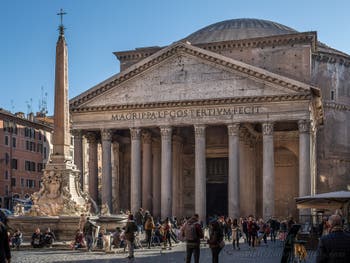
Outside of the Pantheon Seen from the outside, the dome of the Pantheon is barely visible, only on the sides or from the back of the temple.
This dome, barely visible from the outside, surprises visitors who do not expect to find themselves under an immense dome illuminated in the centre by sunlight.
He is surprised to see this light illuminating him from the top of the dome because there are no windows to illuminate the temple’s interior; the Pantheon’s light comes only from his oculus located in the centre of the dome, just above his head.
An Oculus under the Open Sky
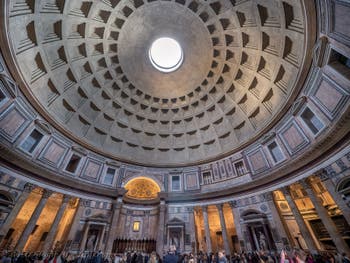
Cupola of the Pantheon The oculus of the Pantheon is not closed; it is open so that when it rains, the water falls directly onto the marble floor, then escapes through small holes drilled in the ground and connected to drains located under the slabs.
The architects of the Pantheon highlighted this oculus measuring 9 meters in diameter with five rows of coffers that precede and support it.
The heights of each of these rows of coffers decrease as you approach the oculus, as do their shape and depth.
The centre of each of these 140 coffers was initially decorated with a bronze rosette.
The Cupola was Built by Pouring Cement
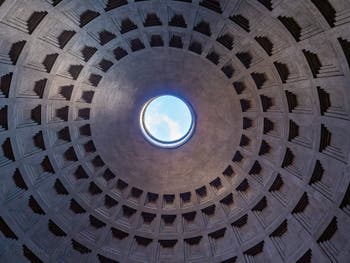
Cupola of the Pantheon The cupola was built according to the method used for the rotunda wall: by pouring cement into wooden moulds supported by a flying frame installed on scaffolding placed at the top of the rotunda's support wall.
The cement was poured in successive layers, as the layer in the previous row was dry and hard.
The shape chosen for the dome coffers had an aesthetic purpose, but it also made it possible to lighten the dome’s weight by removing thickness while structuring the cement.
This reduction is estimated at 5% of the total weight of the dome, which still corresponds to 225 tons, given that the dome weighs 4,500 tons.
The Cupola's Cement: Ingenuity and Technicality
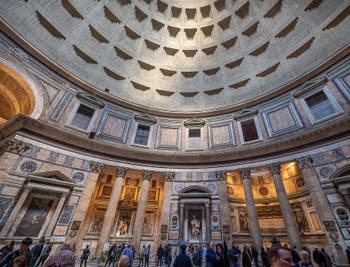
Cupola of the Pantheon We also know that the architects of the Pantheon modified the cement's composition over the entire dome height, making it lighter and lighter as you rose closer to the oculus.
The cement at the bottom of the dome, the heaviest, incorporates pieces of brick, basalt, and travertine.
When rising into the cupola, tuff was integrated into the cement; tuff is a porous volcanic rock.
And in the highest part of the cupola, another volcanic rock has replaced the previous elements: pumice, an extremely light stone but also very hard.
the Cupola exerts All its Weight on its Circumference
Because of its shape, the cupola exerts all its weight on its base and circumference.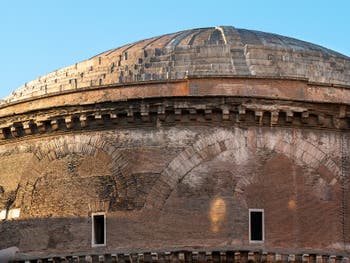
Outside of the Pantheon To prevent the force generated by the weight of the dome on the walls of the rotunda from causing it to collapse, the architects anchored the base of the dome on the inner part of the rotunda wall; the top of the outer wall of the rotunda is higher to contain the pressure.
The architects added rows of external steps over the cupola to limit the risk of the dome collapsing due to the pressure exerted on the rotunda wall.
These rows of steps weigh directly on the bottom and therefore counterbalance the external thrust of the dome.
The Thickness of the Cupola is Decreasing
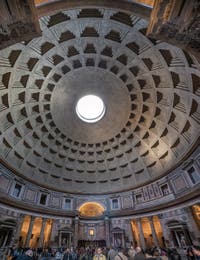
Cupola of the Pantheon Finally, the architects focused on gradually decreasing the dome's thickness to reduce weight.
The thickness of the cupola at its base is the same as that of the rotunda wall: 6 meters, but it gets thinner to its summit, where the dome is only 1.5 to 1.8 meters thick.
Therefore, the dome’s top is the dome’s lightest part.
Impressive ingenuity.
A Dome 43 meters in Diameter at 43 meters High!
The visual power of the dome is linked to its proportions: 43.30 meters in diameter and 43.30 meters in height!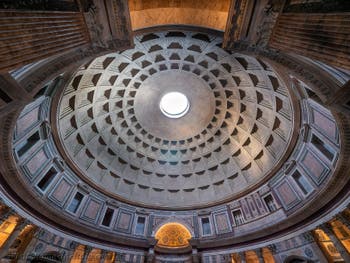
Cupola of the Pantheon Its dimensions were incredible at the time of construction of this masterpiece, which aroused the respect of those who were inspired by its design during the following centuries: the dome of Brunelleschi's Florence Cathedral, as well as that of Saint Peter's Basilica, designed by Michelangelo, are slightly smaller in size than that of the Pantheon.
As a sign of respect for the architects of this temple, Michelangelo wanted the diameter of Saint Peter's dome to be one meter less than that of the Pantheon.
Michelangelo expressed his admiration by saying that the Pantheon was the work of angels and not a human creation.
Avant-Garde Construction Techniques
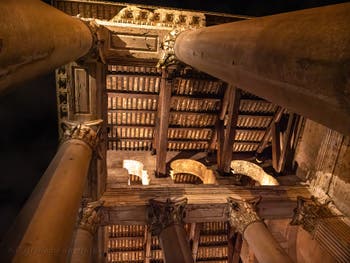
Porch of the Pantheon Until the invention of reinforced concrete, the Pantheon remained the largest covered building without any central or intermediate support existing in the world.
To achieve this feat dating back nearly two thousand years, both for the cupola and its circular enclosure, the architects of the Pantheon relied on an invention already present at the beginning of the Roman Empire: cement.
The Exceptional Cement of the Panthéon
The cement used to build the Pantheon was a mixture of water, sand, lime, and ash called “Pozzolana” from volcanoes and pieces of stone and brick of various sizes.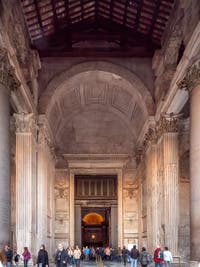
Porch of the Pantheon The Romans found the ingredients needed to prepare cement, taking sand from the beaches of the Mediterranean and lime extracted from limestone blocks from all over the empire.
The use of cement was doubly advantageous because few skilled workers were needed to use it and because it dried quickly and became as hard as a stone.
The 2,000 years of age of the Pantheon, whose structure has remained in perfect condition, prove this.
In recent years we have noticed some cracks in the dome, but they are superficial and do not require repairs.
The advantage of cement
The other great advantage of cement is that you can give it the shape you want by pouring it inside a formwork.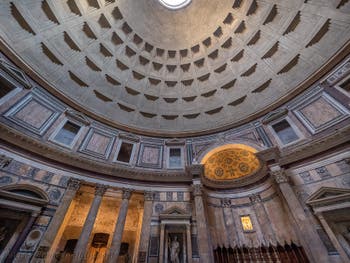
Cupola of the Pantheon By the time the Pantheon was built, the Romans had long learned to make wooden, tile, and brick formwork capable of creating solid cement structures.
Nobody knows exactly the details of the ingredients and proportions used by the Romans to make their cement, elements that our modern architects would like to know well, given the quality of Roman buildings that have stood for more than two thousand years, unlike some more recent buildings.
However, scientists discovered that the critical element in Roman cement would be a mixture of lime and volcanic ash (called pozzolana), which would cause a chemical reaction that could create a particularly resistant end product.
However, no one has yet been able to recreate the type of cement used in ancient Rome.
Next Page: The Pantheon became Christian
Art Story Story | Porch Rotunda | Cupola | Basilica | Chapels Tombs
Pantheon Art Story | Location | Opening Hours Tickets | Authorisations
Back to Top of Page

